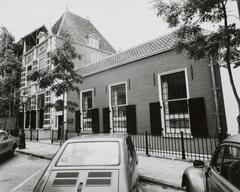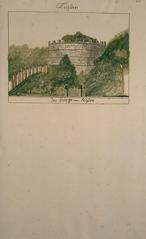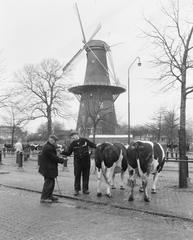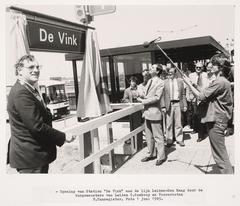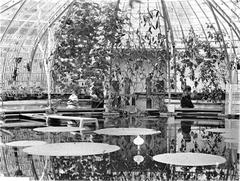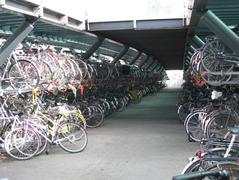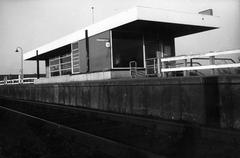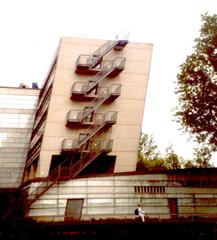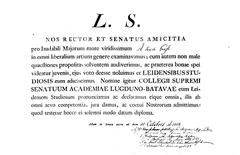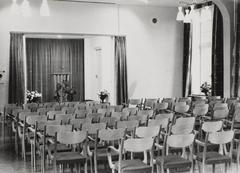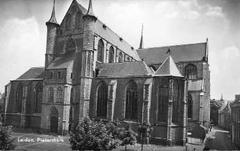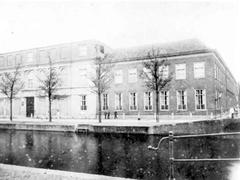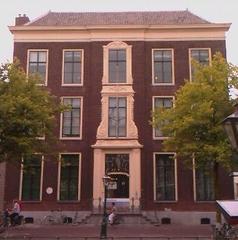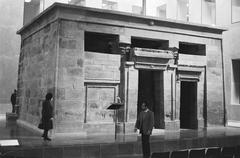Kasteel Paddenpoel: Visiting Hours, Tickets, and Complete Guide to Leiden’s Medieval Heritage
Date: 04/07/2025
Introduction
Kasteel Paddenpoel, located within the historic city of Leiden, Netherlands, offers visitors a captivating journey into the region’s medieval past. Although the castle itself has not survived above ground, its archaeological remnants and layered history provide a meaningful window into the city’s evolution from the late Middle Ages through significant eras such as the Hook and Cod wars and the Eighty Years’ War. This comprehensive guide details Kasteel Paddenpoel’s origins, architectural evolution, archaeological discoveries, cultural significance, and practical information, including visiting hours, tickets, accessibility, and nearby attractions.
For travelers and history enthusiasts alike, visiting Kasteel Paddenpoel offers not only a chance to connect with Leiden’s storied past but also the opportunity to discover the city’s broader network of historical sites. Leiden’s excellent connectivity by train, bicycle, and foot make the castle’s location easily accessible and ideal for exploration as part of a larger itinerary. For the most up-to-date information, visitors are encouraged to consult official tourism resources and local heritage organizations. (visitleiden.nl, Historische Vereniging Oegstgeest, Dag van het Kasteel)
Table of Contents
- Overview and Historical Significance
- Architectural Evolution and Medieval Role
- Key Archaeological Discoveries
- Visiting Information: Hours, Tickets, and Accessibility
- How to Get There
- Nearby Attractions
- Community, Preservation, and Cultural Impact
- Frequently Asked Questions (FAQ)
- Summary and Travel Tips
- References and Further Reading
Overview and Historical Significance
Kasteel Paddenpoel traces its origins to around the 13th century, when it was established as a moated manor within the County of Holland. Its name, derived from the Dutch words for “toad” (pad) and “pool” (poel), reflects the marshy environment near the Old Rhine, which provided natural defense and strategic access to trade routes. As a defensive and administrative hub, the castle played an essential role in overseeing the region and protecting Leiden.
Throughout its history, Kasteel Paddenpoel underwent significant transformations. Initially a defensive stronghold, it evolved into a noble residence during the Renaissance and later faced decline and partial demolition. The site encapsulates Leiden’s shifting social, political, and cultural landscape.
Architectural Evolution and Medieval Role
- Medieval Foundations: Built in the late Middle Ages, Kasteel Paddenpoel featured typical Dutch castle elements: brick fortifications, a central keep, thick defensive walls, and a broad, water-filled moat.
- Defensive Enhancements: During the Hook and Cod wars (1350–1490), the castle’s defenses were upgraded with corner towers and reinforced gatehouses, positioning it as a key fortification in regional conflicts (hollymelody.com).
- Renaissance Residence: In the 16th century, the manor shifted from military outpost to noble estate, reflecting Leiden’s rise as a center of trade, learning, and culture.
- Destruction & Reuse: The castle suffered destruction during the Hook and Cod wars, with notable demolitions in 1393 and again in 1420. In 1428, Boudewijn van Zwieten acquired the site and established the Mariënpoel monastery, marking a transition from military to religious use (Historische Vereniging Oegstgeest).
Key Archaeological Discoveries
Rediscovery and Excavation
Archaeological interest in Kasteel Paddenpoel was rekindled in the 20th century, notably in 1966 during the construction of student housing on the Flanorpad. Excavations revealed substantial medieval masonry, confirming the location of the former castle. Earlier finds in 1927 during villa construction had hinted at the site’s historical significance.
Main Features Uncovered
- Structural Remains: Archaeologists documented foundations of a corner tower, gatehouse, stone-pillared bridge, and moats. These features illustrate the sophistication of medieval Dutch castle design.
- Material Finds: Brick and stone foundations, pottery shards, roof tiles, metal objects, and limited weapon fragments were among the artifacts recovered.
- Chronological Layers: Two main construction phases were identified—Paddenpoel I (late 14th century, destroyed in 1393) and Paddenpoel II (rebuilt post-1396 with enhanced defenses).
Site Layout
The castle comprised an inner bailey with a central keep and towers, encircled by moats and walls, and an outer bailey with service buildings. Stone bridges and dual gatehouses controlled access, underscoring the site’s defensive importance. Kasteel Paddenpoel was closely connected to the Burcht van Leiden, serving as the residence of the city’s burgrave.
Preservation and Current State
While above-ground structures have vanished, the foundations remain preserved beneath modern developments. Occasional archaeological monitoring continues during new construction at the site.
Visiting Information: Hours, Tickets, and Accessibility
Visiting Hours
- The Kasteel Paddenpoel site is an open-air location accessible year-round, 24/7. It is not enclosed or gated.
Tickets
- There is no entrance fee or ticket required to visit the site. Access is free and integrated into public walking and biking routes.
Accessibility
- The site, located near Flanorpad and Leiden University’s science campus, is accessible by foot or bicycle. Terrain is generally flat, but some areas near the moat or old walls can be uneven. Visitors with mobility needs can navigate the main paths safely.
Guided Tours
- While no regular tours are dedicated solely to Kasteel Paddenpoel, local historical societies and the Leiden tourist office occasionally offer walking tours that include the site. Advance booking is recommended for these seasonal offerings.
How to Get There
- By Train: Leiden Centraal Station is a 20-minute ride from Schiphol Amsterdam International Airport. From the station, bus lines 4 or 5 (stop: Wassenaarseweg) or a short bike ride bring you to the site (Visit Leiden).
- By Bicycle: Leiden is bike-friendly, with rentals available at the station and throughout the city (Nova on the Road).
- By Car: Access via A4/A44 highways; parking is available in city center or university facilities.
Nearby Attractions
- De Burcht van Leiden: A medieval fortress with panoramic city views.
- Pieterskerk: Historic Gothic church and landmark.
- Hortus Botanicus: One of the world’s oldest botanical gardens.
- National Museum of Antiquities (Rijksmuseum van Oudheden): Exhibits on ancient history and finds related to Kasteel Paddenpoel (Rijksmuseum van Oudheden).
- Leiden University Botanical Gardens and Museum Quarter: Perfect for combining history and leisure.
Community, Preservation, and Cultural Impact
Kasteel Paddenpoel is a key part of Leiden’s network of over 2,800 historical monuments (Holland Times). Local organizations like the Historische Vereniging Oegstgeest promote awareness and preservation through educational programs, interpretive signage, and guided walks. The castle’s transformation from fortress to monastery, and eventual archaeological rediscovery, reflects broader trends in urban archaeology and heritage conservation.
Frequently Asked Questions (FAQ)
Q: Is Kasteel Paddenpoel open to the public?
A: Yes, the site is freely accessible year-round.
Q: Are tickets or bookings required?
A: No tickets are needed for the site; guided tours may require advance booking.
Q: Is the site wheelchair accessible?
A: The main paths are flat and accessible, but some terrain near the moat is uneven.
Q: What remains can I see at the site?
A: Subtle remnants include moat outlines and wall fragments near Wassenaarseweg and Springerpad.
Q: Are facilities available on-site?
A: There is no visitor center or restrooms; amenities are available in Leiden city center and at the university campus.
Q: What other attractions are nearby?
A: De Burcht van Leiden, Pieterskerk, Hortus Botanicus, and several museums are all within easy reach.
Summary and Travel Tips
Kasteel Paddenpoel is a unique and integral part of Leiden’s medieval heritage, offering visitors insight into the city’s layered past through its archaeological remains and historical narratives. The site is freely accessible, with no ticket requirements, and is easily combined with visits to other key landmarks in Leiden. Interactive maps, digital guides, and seasonal tours enhance the experience, while local historical organizations continue to preserve and interpret its legacy.
For the latest information on guided tours, events, and educational materials, consult official resources and consider using mobile apps or virtual tours.
References and Further Reading
- Visit Leiden – Kasteel Paddenpoel
- Wikiwand – Kasteel Paddenpoel
- Rijksmuseum van Oudheden
- Historische Vereniging Oegstgeest
- Dag van het Kasteel – Kasteel Paddenpoel
- VVV Leiden Tourist Office
- Holland Times – Leiden City of Culture
- Nova on the Road – Things to Do in Leiden
- Tourist Places Guide – Leiden
- Dutch Review – Things to Do in Leiden
